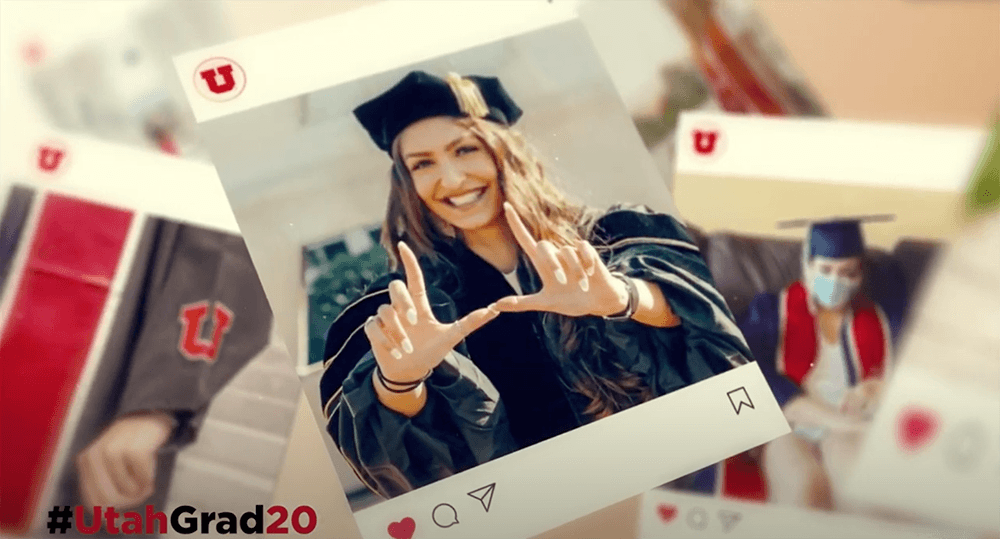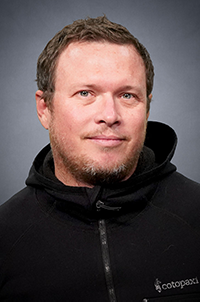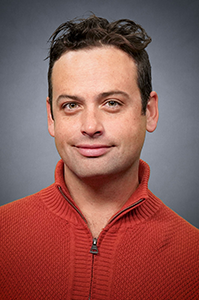You’re accessing archived content
This is archived content from the UIT website. Information may be outdated, and links may no longer function. Please contact stratcomm@it.utah.edu if you have any questions about archived content.
U's 1st virtual graduation successful, thanks to TLT staff

The 2020 University of Utah commencement ceremony was entirely digital, with University Marketing & Communications producing the video, the Center for Disability & Access interpreting it, and Teaching & Learning Technologies streaming it live. (Screenshot)
Any other year, thousands of students, dressed in caps and gowns, would file into in the Jon M. Huntsman Center for a ceremony recognizing the next University of Utah graduating class. There would be applause and cheers, handshakes and hugs, smiles and tears, speeches and warm wishes — all livestreamed for those unable to attend in-person.
But what do you do when an entire country is under varying stay-home orders and guidance to distance socially?
When the university announced it could not hold an in-person graduation on April 30, 2020, due to the COVID-19 pandemic, University Marketing & Communications (UMC), the Center for Disability & Access (CDA), and Teaching & Learning Technologies (TLT) had just a few weeks to figure out how to produce and stream a commencement that looked and felt similar to years past.

Adam Stewart,
associate director for
TLT Operations

Peter Hemingway,
media supervisor

Christopher Dawson,
media supervisor
UMC determined that coordinating a real-time online ceremony would be too difficult, so its marketing director approached TLT Director Jon Thomas about streaming a prerecorded file.
“The administration wanted [graduation] to be a live event even though it was prerecorded,” said Adam Stewart, associate director for TLT Operations. “They wanted the community to join at a certain time and everybody to kind of be together when they were watching the presentation.”
TLT Operations staff typically livestream commencement on Thursday from Huntsman Center and college convocations from 8:00 a.m. to 8:00 p.m. on Friday from three or so campus locations. They rely on Kaltura, the university’s video platform, to broadcast the ceremonies to online viewers.
But this was a bit different.
“We had to figure out a way to livestream the finished video file, which is something we usually don't do,” Stewart said. “When we livestream, typically we're livestreaming a video feed from a camera.”
Despite the changes, Stewart said there wasn’t much discussion among TLT staff about switching to another streaming service. With other platforms, Media Supervisor Peter Hemingway said, they would have difficulty testing the stream in advance as well as less control over settings and future changes, and UMC would have to provide login information for its YouTube account. Since TLT has administrative rights in Kaltura, Stewart said, “we try to put everything through Kaltura whenever possible.”
The Operations team, which includes Media Supervisor Chris Dawson, just had to figure out how to do it.
The week before commencement, the trio returned to their offices at Marriott Library, which had been closed because of COVID-19 restrictions, to experiment. Stewart said they didn’t want to broadcast remotely from a laptop because they couldn’t ensure a stable connection. And, as they figured out, all three would be needed to set up and execute the live stream at the right time.
“We worked out a solution where we played the video file through a VLC [media player] on a computer, took the output to one of our livestreaming encoders, and then streamed it to Kaltura through that encoder,” he said.
Although early tests went well, the Operations team ran into some last-minute hiccups.
They originally planned to test the final product on Wednesday, April 29, 2020, but the video was not completed until later that day because of a local celebrity shout-out segment that was added in to the production. Then UMC needed to change the plan for delivering the finalized program to TLT.
“They weren't able to upload the full file because it was too big for the FTP client they were using,” Stewart said. “So they ended up sending it to us in five parts and then we had to assemble it.”
Dawson stitched the video back together in Adobe Premiere, and the CDA got to work recording American Sign Language (ASL) videos for the accessible versions. CDA staff, Stewart noted, worked all day Thursday to interpret the ceremony, finishing just an hour and a half before the livestream and on-demand videos posted.
Dawson, Hemingway, and Stewart ran additional tests early Thursday with the final production, ensuring that the files and software that would be used during the livestream worked properly, including the code they gave UMC to embed the stream at utah.edu/live.
“It sounds kind of silly … the amount of testing that went into hitting play in VLC. But if we waited until an hour before to test it and the VLC media player didn’t accept the codec, there could be a chance that we wouldn't be able to play the file,” Stewart said. “So we did a lot of testing because you don't want to show up the day of to find out it doesn't work, and then you're scrambling.”
When the moment came for the 6:30 p.m. broadcast, timing was everything. The Operations team knew that Kaltura experiences a 40-45 second delay. If they wanted the ceremony to appear truly livestreamed, they would have to time the preview and go-live just right so viewers didn’t see the player startup information.
Just after Dawson hit play and started the encoder, Hemingway set the preview to stream in Kaltura. Stewart monitored the broadcast and fielded communications with UMC to ensure that they timed everything correctly.
“We were all kind of monitoring our own little section — Chris monitoring the VLC player, [Adam] monitoring the actual stream, and me monitoring Kaltura,” Hemingway said.
After the event, UMC switched out the embedded live player with an on-demand player that can be viewed at any time.
In the past, Stewart estimates, about 600 devices might tune into the broadcast. This year, more than 2,700 devices streamed the event at its peak. Since the on-demand files posted, the recordings have been played more than 2,050 times at utah.edu/live and mediaspace.utah.edu, where the code from Kaltura is embedded, and 1,000 times on the U’s YouTube channel.
In lieu of the in-person event, Stewart said he heard some graduates had virtual watch parties with their families to celebrate.
“It's kind of cool … usually our livestreams aren't watched in that way,” Hemingway said.
All things considered, the U’s first — and possibly last — virtual graduation went fairly well, Stewart said. And looking out of the Marriott Library windows, the day didn’t feel all that different than from previous ones.
“We actually saw graduates walking by outside to go take photos at the big block U, which was kind of cool,” Stewart said. “… It still felt like graduation was going on even though it was virtual.”
TLT graduation efforts
In addition to the official university-wide commencement ceremony, TLT’s Operations team assisted some colleges in planning their virtual convocations.
Some departments, for instance, asked for help bringing together multiple speakers and streaming their presentations through Kaltura or YouTube, where others could view the broadcast but not have to join the call itself. The Operations team also enlisted Verbit to provide live captioning for Zoom graduations — a first for the team.
Node 4
Our monthly newsletter includes news from UIT and other campus/ University of Utah Health IT organizations, features about UIT employees, IT governance news, and various announcements and updates.
